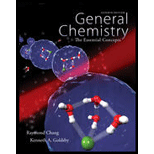
(a)
Interpretation:
Energy change for the given reaction has to be calculated using ionization energy and
Concept Introduction:
Ionization energy is defined as the energy required removing the valence electron of an atom when it is in gaseous state. In periodic table ionization energy of elements decreases down the column or group and increases across the row or period as it is inversely proportional to the atomic size.
Electron affinity is defined as the energy released when an electron is added (gained by an atom) to the atom in its gaseous state forming negative ion. In periodic table electron affinity of elements decreases down the column or group and increases across the row or period as it is inversely proportional to the atomic size.
Hess’s law is applied to calculate the enthalpy changes in a reaction. According to Hess’s law – “The overall enthalpy change of a reaction is equal to the sum of the enthalpy changes involving in each and every individual steps present in the reaction.” Thus if a reaction involves ‘n’ steps then enthalpy change
(a)
Answer to Problem 9.73QP
The energy change for the given reaction is calculated as
Explanation of Solution
The given reaction is,
With reference to table
Energy is released while accepting an electron. Hence the value of electron affinity value carries negative sign as it is energy releasing process.
The given reaction occurs in two steps as shown below. The corresponding change in enthalpy of the reaction is as follows,
In accordance with Hess’s law energy change of the given reaction is equal to the sum of energy changes in the above reaction. Therefore,
(b)
Interpretation:
Energy change for the given reaction has to be calculated using ionization energy and electron affinity values.
Concept Introduction:
Ionization energy is defined as the energy required to remove the valence electron of an atom when it is in gaseous state. In periodic table ionization energy of elements decreases down the column or group and increases across the row or period as it is inversely proportional to the atomic size.
Electron affinity is defined as the energy released when an electron is added (gained by an atom) to the atom in its gaseous state forming negative ion. In periodic table electron affinity of elements decreases down the column or group and increases across the row or period as it is inversely proportional to the atomic size.
Hess’s law is applied to calculate the enthalpy changes in a reaction. According to Hess’s law – “The overall enthalpy change of a reaction is equal to the sum of the enthalpy changes involving in each and every individual steps present in the reaction.” Thus if a reaction involves ‘n’ steps then enthalpy change
(b)
Answer to Problem 9.73QP
The energy change for the given reaction is calculated as
Explanation of Solution
The given reaction is,
With reference to table
Energy is released while accepting an electron. Hence the value of electron affinity value carries negative sign as it is energy releasing process.
The given reaction occurs in two steps as shown below. The corresponding change in enthalpy of the reaction is as follows,
In accordance with Hess’s law energy change of the given reaction is equal to the sum of energy changes in the above reaction. Therefore,
(c)
Interpretation:
Energy change for the given reaction has to be calculated using ionization energy and electron affinity values.
Concept Introduction:
Ionization energy is defined as the energy required to remove the valence electron of an atom when it is in gaseous state. In periodic table ionization energy of elements decreases down the column or group and increases across the row or period as it is inversely proportional to the atomic size.
Electron affinity is defined as the energy released when an electron is added (gained by an atom) to the atom in its gaseous state forming negative ion. In periodic table electron affinity of elements decreases down the column or group and increases across the row or period as it is inversely proportional to the atomic size.
Hess’s law is applied to calculate the enthalpy changes in a reaction. According to Hess’s law – “The overall enthalpy change of a reaction is equal to the sum of the enthalpy changes involving in each and every individual steps in the reaction.” Thus if a reaction involves ‘n’ steps then enthalpy change
(c)
Answer to Problem 9.73QP
The energy change for the given reaction is calculated as
Explanation of Solution
The given reaction is,
With reference to table
Energy is released while accepting an electron. Hence the value of electron affinity value carries negative sign as it is energy releasing process.
The given reaction occurs in two steps as shown below. The corresponding change in enthalpy of the reaction is as follows,
In accordance with Hess’s law energy change of the given reaction is equal to the sum of energy changes in the above reaction. Therefore,
Want to see more full solutions like this?
Chapter 9 Solutions
General Chemistry
 ChemistryChemistryISBN:9781305957404Author:Steven S. Zumdahl, Susan A. Zumdahl, Donald J. DeCostePublisher:Cengage Learning
ChemistryChemistryISBN:9781305957404Author:Steven S. Zumdahl, Susan A. Zumdahl, Donald J. DeCostePublisher:Cengage Learning ChemistryChemistryISBN:9781259911156Author:Raymond Chang Dr., Jason Overby ProfessorPublisher:McGraw-Hill Education
ChemistryChemistryISBN:9781259911156Author:Raymond Chang Dr., Jason Overby ProfessorPublisher:McGraw-Hill Education Principles of Instrumental AnalysisChemistryISBN:9781305577213Author:Douglas A. Skoog, F. James Holler, Stanley R. CrouchPublisher:Cengage Learning
Principles of Instrumental AnalysisChemistryISBN:9781305577213Author:Douglas A. Skoog, F. James Holler, Stanley R. CrouchPublisher:Cengage Learning Organic ChemistryChemistryISBN:9780078021558Author:Janice Gorzynski Smith Dr.Publisher:McGraw-Hill Education
Organic ChemistryChemistryISBN:9780078021558Author:Janice Gorzynski Smith Dr.Publisher:McGraw-Hill Education Chemistry: Principles and ReactionsChemistryISBN:9781305079373Author:William L. Masterton, Cecile N. HurleyPublisher:Cengage Learning
Chemistry: Principles and ReactionsChemistryISBN:9781305079373Author:William L. Masterton, Cecile N. HurleyPublisher:Cengage Learning Elementary Principles of Chemical Processes, Bind...ChemistryISBN:9781118431221Author:Richard M. Felder, Ronald W. Rousseau, Lisa G. BullardPublisher:WILEY
Elementary Principles of Chemical Processes, Bind...ChemistryISBN:9781118431221Author:Richard M. Felder, Ronald W. Rousseau, Lisa G. BullardPublisher:WILEY





